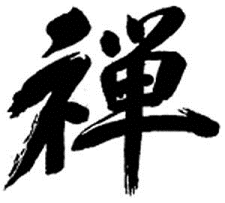The abbot of the Sanbô-Zen |
|
I think that there is no one who has not heard the name Descartes. Rene
Descartes (1596-1650) was a great philosopher and mathematician born in
France. He was a contemporary with the great physicist, Galileo Galilei
(1564-1642), born in Italy Descartes, in Discourse on the Method, a work
published in 1637, wrote, “I think, therefore I am.”1 These words,
signifying the comprehension of the existence of the self as a reality beyond
doubt, formed probably the most famous and most important proposition in the
history of modern philosophy. For that reason Descartes is called the Father of
Modern Philosophy.
The process of Descartes’ cognitive methodology in the Discourse on the Method is, to put it simply: “If something can be doubted even a little, it must be completely rejected.” Those things which we usually think of as correct must be completely rejected should there be even the faintest doubt about them. In such a process even the proposition that 1 + 1 = 2, which seems to be self-evident reasoning, is rejected. However, Descartes asserts that the one thing that cannot be excluded and remains last of all is the perception “I think, therefore I am.” Is this true? Should this be rejected? Certainly there is a self which thinks about the self thinking. This fact cannot be denied. But was Descartes really right? Descartes was mistaken. I cannot help but say so. Perhaps someone will say to me, “Do you really think that you have the knowledge and intelligence sufficient to refute the conclusion drawn by one of the greatest thinkers known to us, someone who thoroughly thought through the problem and reached a conclusion affirmed by everyone?” It goes without saying that I do not have the knowledge and intelligence of Descartes. However, this is not a question of knowledge and intelligence. It is rather a question of the real world discovered through experience. Descartes is mistaken in a number of points.First of all, the proposition itself, “I think, therefore I am” is a tautological contradiction. The contradiction lies in the fact that while the proposition seeks to show the process whereby one can know the existence of “I,” already from the start it is presupposing that existence in the words, “I think.” This contradiction seems at first to be only a matter of word usage and not something essential to the argument. However, it is really closely tied up with the essence of the problem. To think about “Is this correct? Is this mistaken?” is something that cannot be denied. “Thinking” is a reality that cannot be excluded. Up to this point it is true just as Descartes maintained. However, the next step in which Descartes knows the existence of “I” by “therefore I am” is where Descartes fell into error. Where in the world did Descartes bring in this “I”? Where in the world did Descartes find this “I”? I must say that as soon as Descartes started with “I think,” he already had fallen into this error. “Thinking” is a reality that cannot be denied. But there is nothing beyond that reality of “thinking.” No matter where you look, something called “I” does not exist. No matter how much intellectual knowledge you may have, insofar as you do not have this experience, you cannot discover this world. “I think, therefore I am” must be re-phrased as “Thinking, but there is no I.” When Master Joshu was asked what was the world discovered by Shakyamuni (What was the meaning of Bodhidharma’s coming from the West?) he answered, “The oak tree in the garden.” This is a famous koan in the Gateless Gate (Mumonkan).Jôshû is presenting the world of “Thinking, but there is no I.” The oak tree in the garden, besides that tree nothing else exists in heaven or earth--an even less so, a “Joshu” who is looking at it. This is the world that is manifested in this utterance. “The oak tree in the garden, but there is no I.” 1The original French is: Je pense, donc je suis. This was rendered into Latin by a priest friend of Descartes as “Cogito ergo sum.” |
| (translated by Jerome CUSUMANO with the assistance of SATO Migaku)
|
From the “Opening Comments”of Kyosho (Sanbo-Zen's official magazine) 342, 2011 (May/June) |
Returning to Delusion
-
Whenever I hear the word “delusion” used in Buddhism, I gulp. This
misunderstood or simplified teaching – that life is a delusion – leaves me
exasperat...
1 year ago









